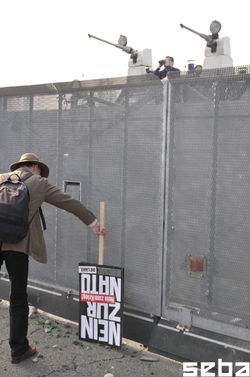We're not the only ones to stifle dissent
Police tactics at the G20 demonstrations reflect an Europe–wide trend to conflate terrorism and protest as equal threats to security
Tony Bunyan
The death of Ian Tomlinson at the G20 protest adds another name to the sad list of those who have died as a result of police tactics at protests. In 1974, Kevin Gateley died in Red Lion Square, during a protest at a National Front meeting. Blair Peach was killed in April 1979, by members of the Metropolitan Police’s Special Patrol Group (SPG). Peach was protesting the National Front’s decision to march through Southall. One SPG officer told a judicial inquiry led by Lord Scarman that his unit had cut through the demonstrators “like knife through butter”. In Italy, Carlo Giuliani was shot dead by police at the G8 protest in Genoa on 20 July 2001. Fifteen-year-old Alexandros Grigoropoulos was shot in Athens in December 2008. The deaths of protestors at the hands of the police are still rare but worryingly they are occuring more frequently and the number of injuries protestors suffer is also on the rise.

This trend seems likely to continue when those in power defend the police’s actions. Lord West, Home Office minister, says he was “extremely proud” of the G20 police and the head of the Association of Chief Police Officers, Sir Ken Jones, called their response “proportionate”. Their reactions appear to condone police violence. Lord West went on to say that in general British police tactics were better than “water cannon, baton rounds or shooting people – all of which seem to occur in some other countries.” But what is the real picture of policing protest tactics across the EU?
The European Union produced two relevant security handbooks, one dealing with international events and another designed to prevent terrorist attacks at the Olympic Games in 2004. In December 2006 they were combined into one Security handbook [pdf] “the security (both from a public order point of view as well as counter-terrorism) of all major international events, be it political, sporting, social, cultural or other”. It also provides information on the gathering of intelligence, how to stop and turn back “suspected” protestors at EU borders and details how to expel protestors in an “efficient” manner if they are detained.
These guides conflate terrorism and protests as equal threats to security and this viewpoint is reflected in a changed police attitude to protests and public order across the EU. The heavy handed policing of protests at the EU summit in Gothenburg, Sweden in June 2001 was followed by repeated police attacks on a demonstrators at a massive protest at the G8 meeting in Genoa in July 2001. This lead to a series of trials[pdf] of both protestors and police officers that have only just finished.
There were similar violent police responses to protests at the World Economic Forum in Davros [pdf] and Evian, the EU summit in Thessaloniki in 2003, the 2005 G8 in Gleneagles and the 2007 G8 meeting in Heiligendamm[pdf], Germany.
An emerging pattern suggests that EU citizens wishing to exercise their democratic right to protest – and to attend cross-border protests – are confronted by para-military style policing, pre-emptive surveillance and raids, denial of entry, preventive detention, the control and dispersal of protests and expulsion from the country, sometimes with a lengthy re-entry ban.
These tactics imperill the right to dissent, an intrinsic democratic right, and endanger the public safety of those attending protests.
For how long will free movement, one of the EU’s founding principles, include the right to cross national borders to protest?
Source: http://www.guardian.co.uk/commentisfree/libertycentral/2009/may/08/civil-liberties-protest



